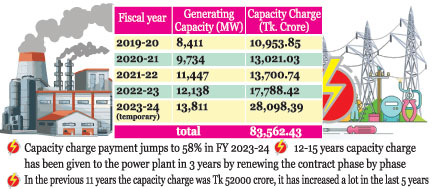Over Tk 1.36 tr sucked thru’ capacity charge
Zarif Mahmud: In the last 15.5 years, power plants have been constructed one after another in the private sector. The construction cost of these power plants, which are licensed without tenders, is considered arbitrary. Again, up to 75 percent of the construction cost is taken from bank loans, which are paid by the government through capacity charges. Despite that, the contracts of the power plants have been renewed phase by phase. And even after paying the construction cost, the capacity charge continues. This is how the electricity sector continues to be looted at will.
An analysis of the Power Development Board (PDB) data shows that in the 16 years from 2008-09 to the outgoing fiscal year 2023-24, about Tk 1.36 trillion (Tk one lakh 36 thousand crore) were given to private sector power plants as capacity charges, a part of which was given directly in dollars. The balance is paid in local currency at exchange rate if not in dollars. And a large part of this capacity charge goes out of the country legally or illegally.
An analysis of the contracts executed by PDB with the power plants gives a clear idea about the capacity charges, which are highlighted here. Let’s say, after getting the license, a company ‘X’ built a power plant, for which the cost is estimated to be Tk 300 crores. The rental power plant was licensed for three years. Although the construction cost of the power plant is Tk 300 crore, the investment of the concerned company is 25-30 percent of the total cost or only Tk 75 crore to Tk 90 crore, which is called equity investment in the agreement. The remaining money is taken as a loan from the bank.
PDB i.e. the government repays the loan (as per the agreement) in three years with interest. Also, the profit (return on equity) is given on the equity investment. Thus, the amount paid by the government every year was the capacity charge. However, even though the government pays the construction cost of the power plant, its ownership remains with the company ‘X’. However, at the end of the term, the contract is renewed again.
A perusal of the renewed contract documents shows that the power plant licensed for maybe three years had a production capacity of 10,000 units (kWh). But 30 percent of it is used during the contract period (three years). At the end of the period, the company applied to renew the contract. Because the power plant’s production capacity remains. After testing, a contract was signed with the company for another two years. But even though the construction cost of the power plant has been paid, the capacity charge is again given.
In the next two years, perhaps another 20 percent of that plant’s capacity, or two thousand kilowatt hours, is used. Then the company again applied to renew the contract. The contract may then be renewed for five years. At that time also the capacity charge is given. However, the quantity is slightly reduced. At that time maybe another 30 percent of the power plant’s capacity is used. The company then applied again and the contract was renewed for another two years. Again, he is given capacity charge.
This is how the three-year power plant has been running for 12 years. However, some rental-quick rental power plants are running for 15-17 years. And this is how the company collected four-point capacity charge from a power plant. As a result, Tk 500-600 crore were withdrawn through capacity charges despite nominal investment.
The analysis of PDB accounts for the last 16 years shows that the capacity charges paid for rental-quick rental and IPPs in the 16 years from 2008-09 to 2023-24 are about Tk 1 lakh 35 thousand 626 crore 71 lakh. In other words, more money than the construction cost of the four Padma Bridges has gone into this sector. Although at this time none of the power plants were fully utilized. Some years even half of the capacity is not used. However, the capacity charge is paid in full every year.
According to the data of PDB, the amount of capacity charge in the financial year 2008-09 was Tk 1,507 crores. In the fiscal year 2009-10, it slightly increased to Tk 1,790 crore. In the financial year 2010-11, the capacity charge increased to Tk 2,784 crore. In fiscal year 2011-12, it jumped to Tk 5,000 crore. After that for a few years the capacity charge was in the range of Tk 5,000 to Tk 6 thousand crore. However, in the fiscal year 2018-19, it has increased to a quarter of Tk 9 thousand crore.
In the financial year 2019-20, the capacity charge has increased to nearly Tk 11,000 crore. In the financial year 2020-21, it further increased to more than Tk 13 thousand crore. In fiscal year 2021-22 it stands at Tk 13,700.74 crore. In the fiscal year 2022-23, Tk 17,788.42 crore is spent in this sector. And in the last financial year 2023-24 (as provisional) the capacity charge has to be paid more than Tk 28,098 crore. That is, in the first 11 years, only Tk 52,064 crores of capacity charges were paid, but in the last five years, the expenditure in this sector has increased to Tk 83,562 crores.
Rare Israeli airstrike in Beirut kills Hezbollah commander and more than a dozen others
International Desk: Israel launched a rare airstrike that killed a senior Hezbollah milita…








